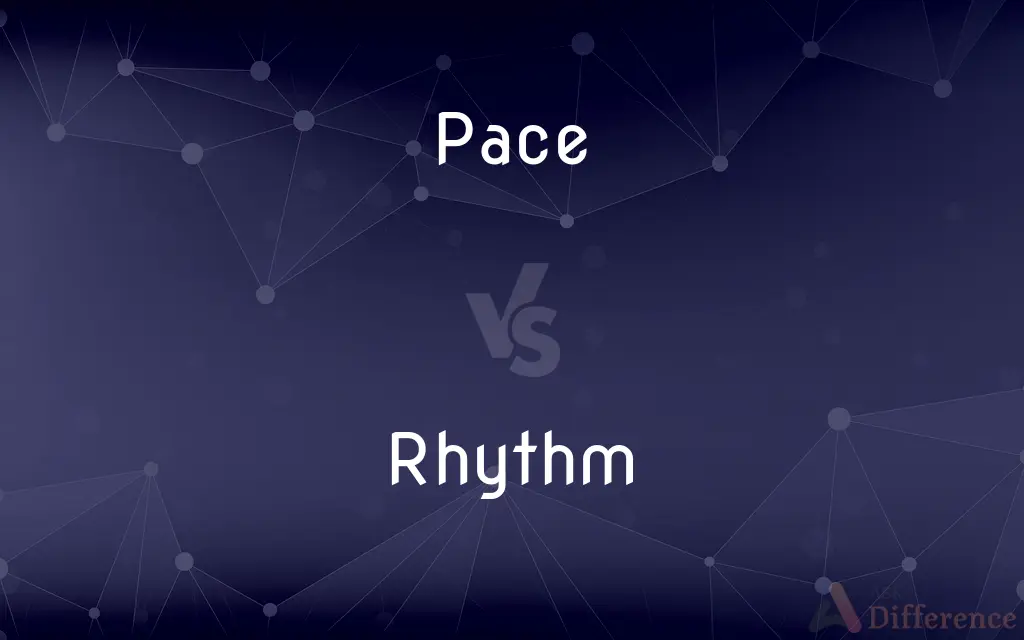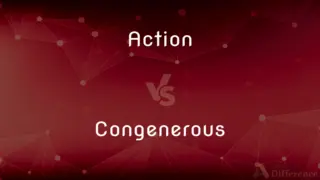Pace vs. Rhythm — What's the Difference?
By Maham Liaqat & Fiza Rafique — Updated on April 1, 2024
Pace refers to the speed at which something moves or progresses, while rhythm is about a pattern or flow in timing and movement.

Difference Between Pace and Rhythm
Table of Contents
ADVERTISEMENT
Key Differences
Pace and rhythm, while both related to movement and time, offer distinct nuances in their application and perception. Pace focuses on the speed or velocity of progression, often measured in terms like miles per hour or steps per minute. It is a critical factor in activities such as running, where maintaining a consistent pace can influence performance outcomes. On the other hand, rhythm delves into the patterned flow of movements or events, emphasizing the regularity and recurrence of these patterns. In music, for instance, rhythm is foundational, guiding the tempo and beat that underpin a piece's overall structure.
Pace is quantifiable, often expressed in numerical terms to denote the speed at which something occurs. For example, in athletics, coaches and athletes pay close attention to pace, striving to achieve specific time goals over distances. This quantification allows for precise adjustments and benchmarks in performance training. Whereas rhythm, by contrast, is qualitative, reflecting the arrangement of sounds, movements, or events in a sequence that creates a pattern. This quality makes rhythm integral to artistic expressions like dance and music, where the timing and sequence of notes or steps produce a cohesive experience.
Pace is inherently linear, focusing on the forward progression of time or distance. It's a concept widely used in contexts where movement from one point to another is measured, such as in racing or speed-based challenges. The emphasis is on how quickly or slowly these transitions occur. Rhythm, however, is cyclical, involving repetition and a predictable sequence. This cyclical nature is evident in the natural world, such as the rhythmic patterns of day and night or the seasons, and in human-created sequences like the verses and choruses of a song.
In terms of human experience, pace can be subjective, varying greatly among individuals. What feels like a brisk pace to one person may be leisurely to another, influenced by personal fitness, perception, and context. This subjectivity means that pace can often be adjusted to suit personal preferences or objectives. Conversely, rhythm can create a shared experience, uniting individuals in a common pattern or tempo. This unifying aspect is particularly noticeable in group activities like group dances or ensemble music performances, where maintaining a collective rhythm is essential for harmony and synchronicity.
Despite their differences, pace and rhythm intersect in many aspects of life, from the arts to athletics. A runner, for example, might use rhythm to maintain a steady pace, counting steps or breaths in a repetitive pattern to enhance endurance and efficiency. Similarly, in music, a steady pace in the progression of a piece helps to establish and maintain its rhythm, guiding the listener through the experience.
ADVERTISEMENT
Comparison Chart
Definition
Speed at which something moves or progresses
Pattern or flow in timing and movement
Measurement
Quantitative (e.g., miles per hour, steps per minute)
Qualitative (e.g., arrangement and sequence of sounds or movements)
Nature
Linear
Cyclical
Application
Athletics, travel, productivity
Music, dance, natural cycles
Human Experience
Subjective and adjustable
Can create a shared experience, unifying in pattern or tempo
Compare with Definitions
Pace
Speed of movement.
The runner's pace was consistent throughout the marathon.
Rhythm
Regular pattern of movement or activity.
The waves crashed against the shore with a soothing rhythm.
Pace
Measurement of time against distance.
The car traveled at an average pace of 60 miles per hour.
Rhythm
Patterned repetition in poetry or prose.
The poet's use of rhythm enhanced the poem's impact.
Pace
Rate of development in a story or event.
The novel's pace quickened towards the climax.
Rhythm
Regularity in personal routines or habits.
Morning exercises became a part of his daily rhythm.
Pace
Speed setting on a device or machine.
He set the treadmill to a brisk walking pace.
Rhythm
Sequence of sounds in music.
The song's rhythm got everyone dancing.
Pace
Progression speed in work or activity.
She maintained a steady pace to meet the project deadline.
Rhythm
Cyclical pattern in nature or life.
She enjoyed the rhythm of the changing seasons.
Pace
A single step taken when walking or running
Kirov stepped back a pace
Rhythm
Rhythm (from Greek ῥυθμός, rhythmos, "any regular recurring motion, symmetry"—Liddell and Scott 1996) generally means a "movement marked by the regulated succession of strong and weak elements, or of opposite or different conditions" (Anon. 1971, 2537).
Pace
Speed in walking, running, or moving
He's an aggressive player with plenty of pace
The ring road allows traffic to flow at a remarkably fast pace
Rhythm
Movement or variation characterized by the regular recurrence or alternation of different quantities or conditions
The rhythm of the tides.
Pace
Walk at a steady speed, especially without a particular destination and as an expression of anxiety or annoyance
We paced up and down in exasperation
She had been pacing the room
Rhythm
The patterned, recurring alternations of contrasting elements of sound or speech.
Pace
Move or develop (something) at a particular rate or speed
Our fast-paced daily lives
The action is paced to the beat of a perky march
Rhythm
The patterning of musical sound, as by differences in the timing, duration, or stress of consecutive notes.
Pace
With due respect to (someone or their opinion), used to express polite disagreement or contradiction
Narrative history, pace some theorists, is by no means dead
Rhythm
A specific kind of such patterning
A waltz rhythm.
Pace
A step made in walking; a stride.
Rhythm
A group of instruments supplying the rhythm in a band.
Pace
A unit of length equal to 30 inches (0.76 meter).
Rhythm
The pattern or flow of sound created by the arrangement of stressed and unstressed syllables in accentual verse or of long and short syllables in quantitative verse.
Pace
The modern version of the Roman pace, measuring five English feet. Also called geometric pace.
Rhythm
The similar but less formal sequence of sounds in prose.
Pace
Thirty inches at quick marching time or 36 at double time.
Rhythm
A specific kind of metrical pattern or flow
Iambic rhythm.
Pace
Five Roman feet or 58.1 English inches, measured from the point at which the heel of one foot is raised to the point at which it is set down again after an intervening step by the other foot.
Rhythm
The sense of temporal development created in a work of literature or a film by the arrangement of formal elements such as the length of scenes, the nature and amount of dialogue, or the repetition of motifs.
Pace
The rate of speed at which a person, animal, or group walks or runs.
Rhythm
A regular or harmonious pattern created by lines, forms, and colors in painting, sculpture, and other visual arts.
Pace
The rate of speed at which an activity or movement proceeds.
Rhythm
The pattern of development produced in a literary or dramatic work by repetition of elements such as words, phrases, incidents, themes, images, and symbols.
Pace
A manner of walking or running
A jaunty pace.
Rhythm
Procedure or routine characterized by regularly recurring elements, activities, or factors
The rhythm of civilization.
The rhythm of the lengthy negotiations.
Pace
A gait of a horse in which both feet on one side are lifted and put down together.
Rhythm
The variation of strong and weak elements (such as duration, accent) of sounds, notably in speech or music, over time; a beat or meter.
Dance to the rhythm of the music.
Pace
To walk or stride back and forth across
Paced the floor nervously.
Rhythm
A specifically defined pattern of such variation.
Most dances have a rhythm as distinctive as the Iambic verse in poetry
Pace
To measure (a space) by counting the number of steps needed to cover a distance.
Rhythm
A flow, repetition or regularity.
Once you get the rhythm of it, the job will become easy.
Pace
To walk (a number of steps) in so measuring a space.
Rhythm
The tempo or speed of a beat, song or repetitive event.
We walked with a quick, even rhythm.
Pace
To set or regulate the rate of speed for (a race or a competitor in a race).
Rhythm
The musical instruments which provide rhythm (mainly; not or less melody) in a musical ensemble.
The Baroque term basso continuo is virtually equivalent to rhythm
Pace
To lead (one's team or teammates) with a good performance
Paced her team to a victory with 18 points.
Rhythm
A regular quantitative change in a variable (notably natural) process.
The rhythm of the seasons dominates agriculture as well as wildlife
Pace
To advance or develop (something) for a particular purpose or at a particular rate
Paced the lectures so as not to overwhelm the students.
Rhythm
Controlled repetition of a phrase, incident or other element as a stylistic figure in literature and other narrative arts; the effect it creates.
The running gag is a popular rhythm in motion pictures and theater comedy
Pace
To train (a horse) in a particular gait, especially the pace.
Rhythm
A person's natural feeling for rhythm.
That girl's got rhythm, watch her dance!
Pace
To walk with long deliberate steps.
Rhythm
In the widest sense, a dividing into short portions by a regular succession of motions, impulses, sounds, accents, etc., producing an agreeable effect, as in music poetry, the dance, or the like.
Pace
To go at the pace. Used of a horse or rider.
Rhythm
Movement in musical time, with periodical recurrence of accent; the measured beat or pulse which marks the character and expression of the music; symmetry of movement and accent.
Pace
With the permission of; with deference to. Used to express polite or ironically polite disagreement
I have not, pace my detractors, entered into any secret negotiations.
Rhythm
A division of lines into short portions by a regular succession of arses and theses, or percussions and remissions of voice on words or syllables.
Pace
Step.
Rhythm
The harmonious flow of vocal sounds.
Pace
A step taken with the foot.
Rhythm
The basic rhythmic unit in a piece of music;
The piece has a fast rhythm
The conductor set the beat
Pace
The distance covered in a step (or sometimes two), either vaguely or according to various specific set measurements.
Even at the duel, standing 10 paces apart, he could have satisfied Aaron’s honor.
I have perambulated your field, and estimate its perimeter to be 219 paces.
Rhythm
Recurring at regular intervals
Pace
Way of stepping.
Rhythm
An interval during which a recurring sequence of events occurs;
The neverending cycle of the seasons
Pace
A manner of walking, running or dancing; the rate or style of how someone moves with their feet.
Rhythm
The arrangement of spoken words alternating stressed and unstressed elements;
The rhythm of Frost's poetry
Pace
Any of various gaits of a horse, specifically a 2-beat, lateral gait.
Rhythm
Natural family planning in which ovulation is assumed to occur 14 days before the onset of a period (the fertile period would be assumed to extend from day 10 through day 18 of her cycle)
Pace
Speed or velocity in general.
Pace
(cricket) A measure of the hardness of a pitch and of the tendency of a cricket ball to maintain its speed after bouncing.
Pace
(collective) A group of donkeys.
Pace
(obsolete) Passage, route.
Pace
(obsolete) One's journey or route.
Pace
(obsolete) A passage through difficult terrain; a mountain pass or route vulnerable to ambush etc.
Pace
(obsolete) An aisle in a church.
Pace
Easter.
Pace
(cricket) Describing a bowler who bowls fast balls.
Pace
To walk back and forth in a small distance.
Pace
To set the speed in a race. en
Pace
To measure by walking.
Pace
(formal) With all due respect to.
Pace
A single movement from one foot to the other in walking; a step.
Pace
The length of a step in walking or marching, reckoned from the heel of one foot to the heel of the other; - used as a unit in measuring distances; as, he advanced fifty paces.
Pace
Manner of stepping or moving; gait; walk; as, the walk, trot, canter, gallop, and amble are paces of the horse; a swaggering pace; a quick pace.
To-morrow, and to-morrow, and to-morrow,Creeps in this petty pace from day to day.
In the military schools of riding a variety of paces are taught.
Pace
A slow gait; a footpace.
Pace
Specifically, a kind of fast amble; a rack.
Pace
Any single movement, step, or procedure.
The first pace necessary for his majesty to make is to fall into confidence with Spain.
Pace
A broad step or platform; any part of a floor slightly raised above the rest, as around an altar, or at the upper end of a hall.
Pace
A device in a loom, to maintain tension on the warp in pacing the web.
Pace
The rate of progress of any process or activity; as, the students ran at a rapid pace; the plants grew at a remarkable pace.
Pace
To go; to walk; specifically, to move with regular or measured steps.
Pace
To proceed; to pass on.
Or [ere] that I further in this tale pace.
Pace
To move quickly by lifting the legs on the same side together, as a horse; to amble with rapidity; to rack.
Pace
To pass away; to die.
Pace
To walk over with measured tread; to move slowly over or upon; as, the guard paces his round.
Pace
To measure by steps or paces; as, to pace a piece of ground. Often used with out; as, to pace out the distance.
Pace
To develop, guide, or control the pace or paces of; to teach the pace; to break in.
If you can, pace your wisdomIn that good path that I would wish it go.
Pace
The rate of moving (especially walking or running)
Pace
The distance covered by a step;
He stepped off ten paces from the old tree and began to dig
Pace
The relative speed of progress or change;
He lived at a fast pace
He works at a great rate
The pace of events accelerated
Pace
A step in walking or running
Pace
The rate of some repeating event
Pace
A unit of length equal to 3 feet; defined as 91.44 centimeters; originally taken to be the average length of a stride
Pace
Walk with slow or fast paces;
He paced up and down the hall
Pace
Go at a pace;
The horse paced
Pace
Measure (distances) by pacing;
Step off ten yards
Pace
Regulate or set the pace of;
Pace your efforts
Common Curiosities
How does rhythm affect music?
Rhythm affects music by creating patterns of sound and silence that establish the tempo and mood of a piece.
What is pace in running?
Pace in running refers to the speed at which a runner moves, typically measured in minutes per mile or kilometer.
How does pace influence productivity?
The pace at which work or activities are conducted can significantly affect productivity levels, with both too slow and too fast paces potentially hindering progress.
Can pace be adjusted?
Yes, pace can be adjusted depending on the context, such as increasing speed in running or slowing down work progression.
How do you measure pace?
Pace is measured by calculating the time it takes to cover a specific distance, often in minutes per mile or kilometer.
Is rhythm always musical?
No, rhythm can also refer to patterns in movement, speech, writing, or natural phenomena, not just music.
How is pace related to time management?
Pace is related to time management by influencing how quickly or slowly tasks are completed, affecting overall efficiency and productivity.
Is rhythm important in poetry?
Yes, rhythm is fundamental in poetry, where it contributes to the poem's structure, flow, and emotional impact.
What role does rhythm play in dance?
Rhythm plays a crucial role in dance by guiding the timing, flow, and coordination of movements.
Can rhythm be found in everyday life?
Yes, rhythm can be found in daily routines, natural cycles, and habitual patterns of activity.
What's the difference between pace and speed?
Pace often refers to the rate of progress in a specific context, like running or work, while speed is a more general term for how fast something moves regardless of the context.
Does rhythm contribute to a song's genre?
Yes, the rhythm can help define a song's genre by its characteristic patterns and tempos, distinguishing between styles like rock, jazz, or hip-hop.
Can changing the pace affect one's mood?
Yes, altering the pace of activities, such as slowing down for relaxation or speeding up for excitement, can significantly impact one's mood.
How do athletes use pace?
Athletes use pace to gauge and adjust their speed during training and competitions to optimize performance.
Can a person have a natural rhythm?
Yes, individuals can have natural rhythms in their movements, speech, and daily activities that reflect their personal patterns and habits.
Share Your Discovery

Previous Comparison
Action vs. Congenerous
Next Comparison
Benefactor vs. PhilanthropistAuthor Spotlight
Written by
Maham LiaqatCo-written by
Fiza RafiqueFiza Rafique is a skilled content writer at AskDifference.com, where she meticulously refines and enhances written pieces. Drawing from her vast editorial expertise, Fiza ensures clarity, accuracy, and precision in every article. Passionate about language, she continually seeks to elevate the quality of content for readers worldwide.














































